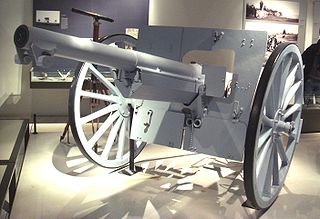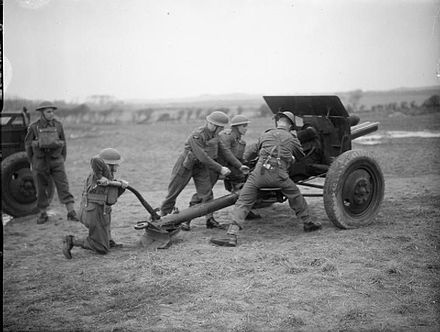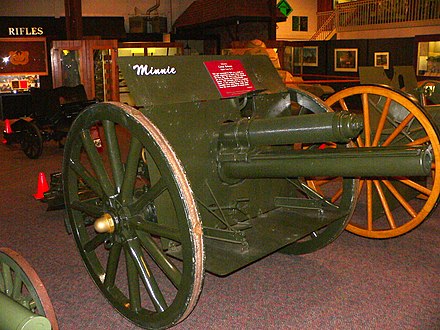
The Ordnance Quick-Firing 17-pounder was a 76.2 mm (3 inch) gun developed by the United Kingdom during World War II. It was used as an anti-tank gun on its own carriage, as well as equipping a number of British tanks. Used with the APDS shot, it was capable of defeating all but the thickest armour on German tanks. It was used to 'up-gun' some foreign-built vehicles in British service, notably to produce the Sherman Firefly variant of the US M4 Sherman tank, giving British tank units the ability to hold their own against their German counterparts. In the anti-tank role, it was replaced after the war by the 120 mm BAT recoilless rifle. As a tank gun, it was succeeded by the 84 mm 20 pounder.

The Ordnance QF 25-pounder, or more simply 25-pounder or 25-pdr, was the major British field gun and howitzer during the Second World War, possessing a 3.45-inch (87.6 mm) calibre. It was introduced into service just before the war started, combining high-angle and direct-fire, relatively high rates of fire, and a reasonably lethal shell in a highly mobile piece. It remained the British Army's primary artillery field piece well into the 1960s, with smaller numbers serving in training units until the 1980s. Many Commonwealth of Nations countries used theirs in active or reserve service until about the 1970s and ammunition for the weapon is currently being produced by Pakistan Ordnance Factories.
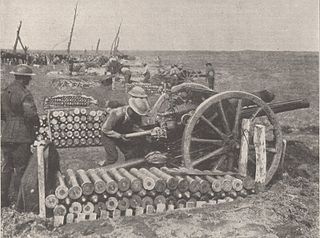
The Ordnance QF 18-pounder, or simply 18-pounder gun, was the standard British Empire field gun of the First World War-era. It formed the backbone of the Royal Field Artillery during the war, and was produced in large numbers. It was used by British Forces in all the main theatres, and by British troops in Russia in 1919. Its calibre (84 mm) and shell weight were greater than those of the equivalent field guns in French (75 mm) and German (77 mm) service. It was generally horse drawn until mechanisation in the 1930s.

The BL 4.5 inch Medium Gun was a British gun used by field artillery in the Second World War. It had nothing in common with the QF 4.5 inch Howitzer or the QF 4.5 inch AA Gun.

The US 75 mm gun tank gun M2 and the later M3 were the standard American tank guns of World War II, used primarily on the two main American medium tanks of the war, the M3 Lee and the M4 Sherman.

The Ordnance QF 13-pounder (quick-firing) field gun was the standard equipment of the British and Canadian Royal Horse Artillery at the outbreak of World War I.
The Allies of World War II cooperated extensively in the development and manufacture of new and existing technologies to support military operations and intelligence gathering during the Second World War. There are various ways in which the allies cooperated, including the American Lend-Lease scheme and hybrid weapons such as the Sherman Firefly as well as the British Tube Alloys nuclear weapons research project which was absorbed into the American-led Manhattan Project. Several technologies invented in Britain proved critical to the military and were widely manufactured by the Allies during the Second World War.

The 7.7 cm Feldkanone 96 neuer Art was a field gun used by Germany in World War I.
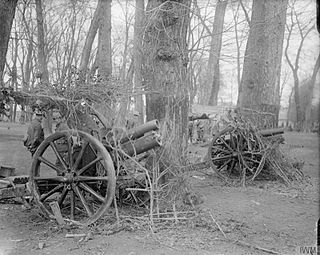
The Ordnance QF 4.5-inch howitzer was the standard British Empire field howitzer of the First World War era. It replaced the BL 5-inch howitzer and equipped some 25% of the field artillery. It entered service in 1910 and remained in service through the interwar period and was last used in the field by British forces in early 1942. It was generally horse drawn until mechanisation in the 1930s.

The QF 2.95-inch mountain gun was the designation given by the British to a Vickers 75 mm calibre gun. It was originally produced for the Egyptian Army. It was taken into British service in the late 19th Century to provide the 'movable armament' at some coaling stations. Also known as 'The Millimetre Gun', it was used by the West African Frontier Force in several theatres in Africa during World War I. It was also used by United States and Philippines.
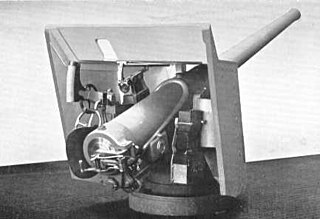
The QF 4.7-inch Gun Mks I, II, III, and IV were a family of British quick-firing 4.724-inch (120 mm) naval and coast defence guns of the late 1880s and 1890s that served with the navies of various countries. They were also mounted on various wheeled carriages to provide the British Army with a long range gun. They all had a barrel of 40 calibres length.

The Canon de 155 C modèle 1917 Schneider, often abbreviated as the C17S, was a French howitzer designed by Schneider. It was essentially the Canon de 155 C modèle 1915 Schneider fitted with a different breech to use bagged propellant rather than the cartridge cases used by the older howitzer. It was used by France, Italy, Russian Empire, Belgium and the United States from 1917 during World War I and was widely exported after the war. Surviving weapons were in service with France, Poland, Greece, Italy, Belgium, the United States and Finland during World War II. Captured weapons were used by the Germans for their 2nd-line artillery and coast defense units.
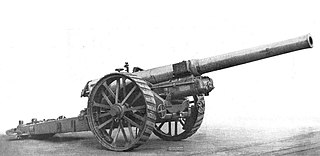
The British BL 6-inch gun Mk XIX was introduced in 1916 as a lighter and longer-range field gun replacement for the obsolescent BL 6-inch gun Mk VII.

The Ordnance QF Hotchkiss 6 pounder gun Mk I and Mk II or QF 6 pounder 8 cwt were a family of long-lived light 57 mm naval guns introduced in 1885 to defend against new, small and fast vessels such as torpedo boats and later submarines. There were many variants produced, often under license which ranged in length from 40 to 58 calibers, but 40 caliber was the most common version.
A quick-firing gun is an artillery piece, typically a gun or howitzer, which has several characteristics which taken together mean the weapon can fire at a fast rate. Quick-firing was introduced worldwide in the 1880s and 1890s and had a marked impact on war both on land and at sea.

The QF 1 pounder, universally known as the pom-pom due to the sound of its discharge, was a 37 mm British autocannon, the first of its type in the world. It was used by several countries initially as an infantry gun and later as a light anti-aircraft gun.

The 3-inch field gun M1902 (76.2 mm), a.k.a. M1904 and M1905, was the U.S. Army’s first nickel steel, quick-firing field gun with a recoil mechanism. Like its predecessor the 3.2-inch gun M1897, it was a rifled breechloader.

The 6 inch Howitzer, Model of 1908 was the standard American heavy howitzer before World War I. Forty-two of these weapons had been produced before 1917 and all were employed for training stateside in that war. Although this weapon appears in World War I-era tables of organization and equipment, for combat use in France the Canon de 155 C mle 1917 Schneider was purchased, and remained the standard weapon of this class until early World War II. All surviving weapons were retired during the 1920s.

The QF 6 pounder Nordenfelt was a light 57 mm naval gun and coast defence gun of the late 19th century used by many countries.

Ordnance QF 3 inch howitzer was a howitzer fitted to British cruiser and infantry type tanks of the Second World War so they could fire a smoke shell in "close support" of other tanks or infantry. HE shells were also available. Earlier British tanks were fitted with a 3.7 in howitzer.


